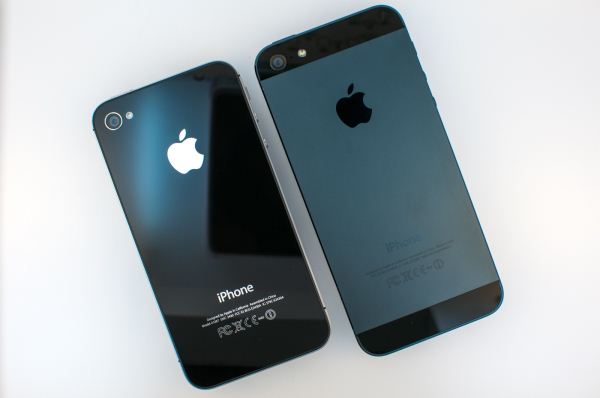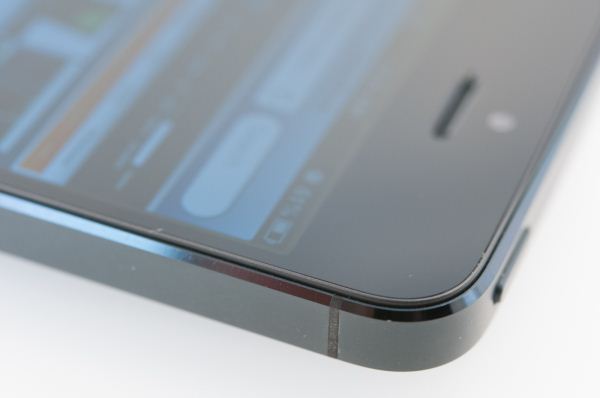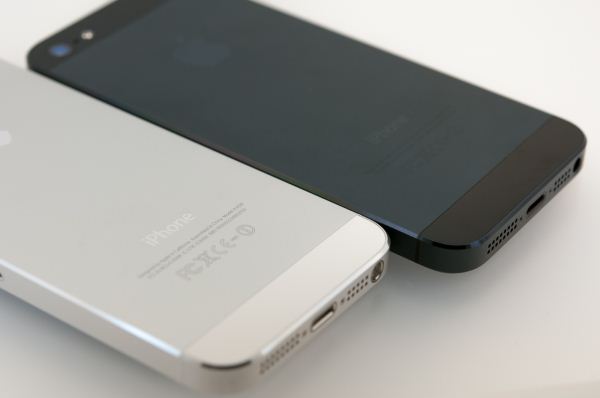The iPhone 5 Review
by Anand Lal Shimpi, Brian Klug & Vivek Gowri on October 16, 2012 11:33 AM EST- Posted in
- Smartphones
- Apple
- Mobile
- iPhone 5
Design
Section by Vivek Gowri
The iPhone 4, when it launched, represented a clean break for Apple's industrial design. It replaced the soft organic curvature of the iPhone 3G/3GS with a detailed sandwich of metal and glass, something that arguably brought the feel of a premium device to a new level. Obviously, Apple had their fair share of issues with the design initially, and nothing could match the sinking feeling of dropping one and shattering the glass on the front and back simultaneously, but it was a small price to pay for the jewel-like feel of the device. Combined with the (at the time) incredible pixel density of the then-new Retina Display, the iPhone 4 was a revolution in hardware design. The chassis has aged remarkably well over the last two-plus years, so naturally it's a hard act to follow.
The 5 keeps a similar design language to the 4, keeping roughly the same shape as before but with a taller and thinner form factor. At first glance, the 5 actually looks almost the same as the 4, with an unbroken glass front face, prominent corner radiuses, the familiar home button, a rectangular cross-section, and metallic sides with plastic antenna bands. However, those metallic sides are part of an anodized aluminum frame that makes up a majority of the body, and that's where the industrial design diverges from the 4 and 4S.
In contrast to the predominantly glass body of the previous generation iPhone, the 5 is almost entirely aluminum other than the glass front face and two small glass windows at the top and bottom of the back. It's a return to the original iPhone/3G/3GS-style of construction, with the front glass clipping into a unibody chassis. It's a significant departure from the 4 and 4S, where the stainless steel band in the center was the main housing that the front and rear panels clipped into. That was pretty radical way of doing things, so it's not all that surprising to see Apple revert to a more conventional and less complex method for the 5.
The aesthetic is actually pretty awesome, especially in the black version. The combination of black glass and off-black aluminum (Apple is calling it slate) gives the 5 an almost murdered out look that's three parts elegant and one part evil. The white and silver model has a classy look that's much friendlier in appearance than the black one. The color schemes and overall design aesthetic remind me of the Dell Adamo, one of my favorite notebook designs of all time. The similarities may be purely coincidental, but it's interesting to note nonetheless and should give you an idea of how premium the industrial design is.
All three previous iPhone body styles had very similar dimensions, so the biggest question with the 5 was how much the larger display would do to change that. Unlike many Android manufacturers, Apple still believes in things like small pockets, small hands, and one-handed smartphone usage. With the 5 being vertically stretched but no wider than the previous iPhones, the biggest impact on in-hand feel is actually the thinner body. If you're used to a larger Android or Windows device, the change seems radical, but even compared to the 22% thicker iPhone 4S, it feels a good deal smaller.
It's not just the minimized z-height though, the 25% weight loss is definitely also a factor. Even a few weeks later, I still find it striking how much less substantial it feels than the 4 and 4S. The densely-packed glass body just had a reassuring weight to it that the 5 simply lacks. But as you get used to the new form factor, you realize how far Apple is pushing the boundaries of ultrathin design. When the 4th generation iPod touch came out, I told Brian that I wanted an iPhone with that form factor - well, the 5 is essentially there (0.3mm thicker and 11 grams heavier, but close enough). It's pretty impressive to think about. If you thought the 4S was one of the best phone designs on the market in terms of aesthetics and build quality, the iPhone 5 just pushes that advantage further.



















276 Comments
View All Comments
Sufo - Tuesday, October 16, 2012 - link
Agreed. If his goal is to fly the flag for apple (who clearly need no flag flying - look at their stock prices, but i digress...), and discredit its detractors, he's doing an awful job. But then again, I do detect a whiff of troll.Spunjji - Friday, October 19, 2012 - link
Word.doobydoo - Saturday, October 20, 2012 - link
Bragging? About being an engineer?LOL
dagamer34 - Tuesday, October 16, 2012 - link
If you wanted a "should I upgrade to this phone" review, there are hundreds of those reviews online. But AnandTech is pretty much the only place where you get a definitive review worth reading 5 years from now. They leave no stone unturned.Arbee - Tuesday, October 16, 2012 - link
Agreed. "Should I upgrade" is covered by literally dozens of newspapers, TV shows, and websites (Engadget, The Verge, Gizmodo, All Things D just to name 4). AT is the home of the 15+ page deep dive, and they do it just as well for Androids and Windows Phones.Also, I'm completely positive that if you sent Brian a GS3 with the iPhone 5's camera he'd write about it in exactly the same way. 2 weeks ago DPReview covered the iPhone 5's camera in a very similar way (including the same suggestions on how to avoid the problem, and a demonstration of inducing similar artifacts on the iPhone 4S and a couple of Android handsets). Optics is not a soft science, there is no room for fanboyism.
rarson - Wednesday, October 17, 2012 - link
I totally disagree. He brings up a completely valid point because Anandtech usually separates the reviews from the in-depth tech examinations. There's absolutely no need for the review to be 20 pages when most people are looking for benchmarks and hands-on impressions. Considering the fact that going this in-depth made the review late, it makes no sense at all.At least half of this information in this article doesn't even fall under the category of a review.
darkcrayon - Tuesday, October 16, 2012 - link
I think this type of review (hell, the site in general) is directed at people that want the maximum amount of compiled nitty gritty techy details... Notice his review was weeks after the larger more general consumer oriented sites. I think anyone wanting to know whether they should upgrade, that isn't interested in the technical details of the A6, would be better served reading those reviews anyway.Anand has said in previous reviews that he felt that iOS was intended to be more of an "appliance" OS. It's a pretty apt comparison of the two actually. That focus is why you can side load and more easily put custom software on Android, and also why you'll need anti-malware software for it before long as well. The point of an appliance is to have a reliable, consistent device that you spend more time using than tweaking.
daar - Wednesday, October 17, 2012 - link
Point taken, darkcrayon.I prefer AT's reviews because they do a thorough and unbiased job at detailing/benchmarking and comparing different products. The suggestion was that the info about the SoC be split on it's own. If Intel released a new chip, call it i9, and the first sample was from an Alienware notebook, I would simply be suggesting that the technical info about the chip have it's own post and not be combined with the review of the notebook is all.
I find it a bit strange that people are suggesting to go to other websites when I made the comment of comparisons to other products, and quite unlike most posts in AT reviews. If I make a comment about a few ATI features not being compared with Nvidia's, I would have been surprised to have people to tell me to go visit Tom's Hardware or the like.
Not to say there wasn't any comparisons, but rather in contrast to say, for example, the One X review where Brian made the comment of how the construction of the device felt better than the GS3. It felt like punches were being pulled in this review is all.
phillyry - Sunday, October 21, 2012 - link
Anand,I would like to know, however, how an Android device serves more as an all purpose device than an iPhone.
Did you mean because of its customisable skins or because it can do some things that an iPhone cannot - presumably because of Apple's strong hold ('death grip') on the OS?
This is pretty important to me because I am near the end of the term of my agreement and am in the market for a new 'phone'. I've considered W8P for precisely this reason but am waiting to see if they flop or not. I've always thought of Android as pretty darn similar to iOS but with slightly different interfaces and less user restrictions.
Is there some other factor that makes an Android any more like a pocket computer, like the future x86 W8P phones will presumably eventually be, and less like an iPhone than I have imagined?
phillyry - Sunday, October 21, 2012 - link
I also took notice of it when Anand referred to the iPhone as an appliance. Your remark saying, "The point of an appliance is to have a reliable, consistent device that you spend more time using than tweaking" would be comforting but I don't think that that's quite how Anand meant it. I was actually quite put off by the term because I think that he meant that the iPhone is made to be more of a tag along device that goes with your other Macs and plays a support role rather than a stand alone device. He pretty much says as much.Like I said, I found this a bit off putting but I think he's just saying how he sees it in terms of the respective companies' product lines and agendas. It actually makes a fair bit of sense. I found that when I got an iPhone it made me want an iPad. And then when I got an iPad it made me want a MacBook. Call it what you will but I remember thinking that they should be able to make it so that I can do everything I need to on an iPad but distinctly felt like I really needed a MacBook to really do all that I wanted. It could be argued, along the lines of Anand's original comment, that this is Apple's approach / business model.
It also points to a distinction between Apple and the other big player that no one in this forum is talking about - Microsoft. Windows 8 appears to be meant to be the exact opposite of this approach. Instead of one device for each purpose it's one device for all purposes. It will be interesting to see if Microsoft's approach with Windows 8 will turn things around or simply flop, at least on the handheld device side of things.